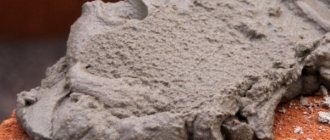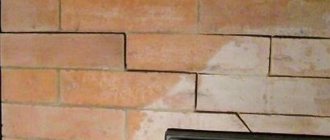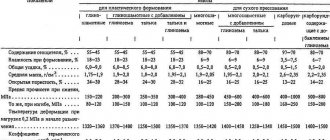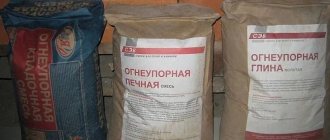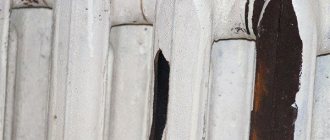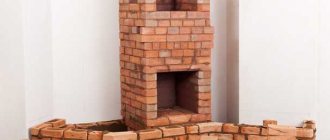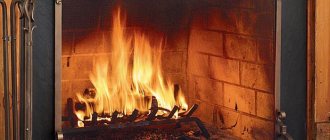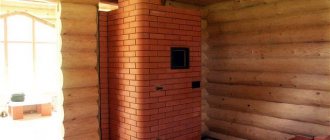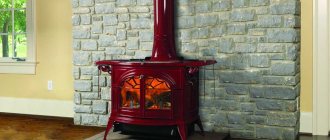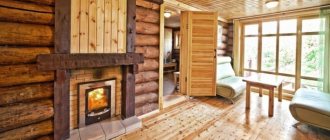Not only the durability of the structure, but also its characteristics such as efficiency and safety depend on how high-quality the mortar for laying the fireplace is. If mortar spalls in the seams of unlined brick or masonry, carbon monoxide and other combustion products can enter the room and cause poisoning to those present in it. The reverse process (suction of air from the room through the cracks) is also undesirable, since it is accompanied by an increase in fuel consumption and a deterioration in the performance of the fireplace.
Fireplace diagram.
Selection and preparation of sand
The simplest solution includes clay and sand. The best sand is traditionally considered to be mountain sand - it has a rough surface texture, thanks to which the solution significantly enhances the quality of the connection of masonry bricks. Sea and river sand turns out to be not so good against the backdrop of mountain sand - water polishes the surface of the grains of sand, as a result of which they lose their adhesive properties.

Immediately before creating the solution, it is recommended to sift the sand through a sieve with 1.5 mm cells. If, even after sifting, impurities remain visible in the sand, it must be washed with water. Sand for washing is scattered on a stretched burlap, and a stream of water is directed at it. You can finish washing only after the water becomes clear after passing through the sand.
Fat content of clay
In order for the solution for stoves and fireplaces to be of high quality, before mixing it, it is necessary to determine the degree of plasticity of the clay, which directly affects the proportions of the components of the masonry mixture and the strength of the finished structure.
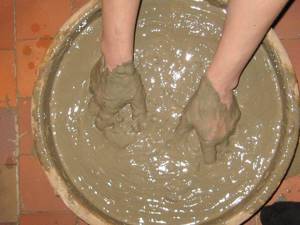
To check the fat content of clay, the following technology is used:
- Clay for the fireplace is kneaded to a stiff dough and kneaded. A ball with a diameter of about 5 cm is created from the finished mass, which is subsequently clamped using two planks. The planks need to be gradually compressed, observing how the formed ball behaves.
- Material of the right consistency begins to crack when the planks compress it to a third of its thickness. If cracks appear earlier, then the clay is too thin, and the opposite picture indicates increased fat content of the material.
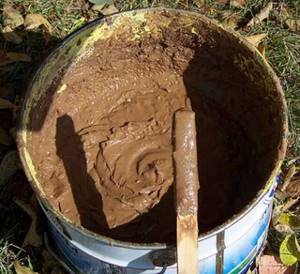
Clay that has insufficient fat content is not suitable for mixing the solution - when using oven equipment, cracks will appear in the masonry, reducing the strength of the structure. Excessively oily clay for stoves and fireplaces usually leads to increased shrinkage of the masonry, but in this case there is a solution - you just need to add more sand to the solution.
Practical tips for using the mixture
If you violate the generally accepted rules for laying stoves, then even with very high-quality mixtures you can get an outright defect. What do the professionals advise?
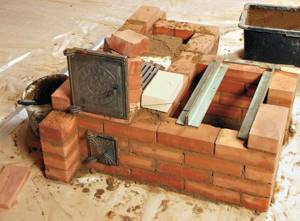
The quality of the furnace masonry depends not only on the mortar
- The clay should only be mixed with a special mixer; you can never achieve a homogeneous composition manually.
- The solution can be left for an unlimited amount of time. After drying, water is added and the composition is mixed. This cannot be done with cement-based solutions; once they harden, they cannot be corrected.
- Work is allowed only at temperatures not lower than +10°C. The bricks must be dry; the rate of moisture absorption does not affect the strength parameters.
- The first time the stove can be lightly heated no earlier than three days after the completion of the masonry. It is strictly not recommended to rush; if the recommendations are not followed, large cracks may appear through which smoke enters the room.
- To lay the outer row of the outer chimney, cement should be added to the mixture. Ordinary clay with sand is afraid of moisture and gradually erodes outdoors. Cement mortar does not react to the negative effects of natural precipitation.

For laying the chimney, use a solution containing cement.
Efflorescence may appear on poor-quality seams after the first fire, and white marks may be visible on the surface. This is a very unpleasant phenomenon and is removed over a long period of time. The efflorescence should be carefully scraped off, and then the surface should be trimmed with a damp cloth. Such actions will have to be repeated until the salts are completely eliminated.
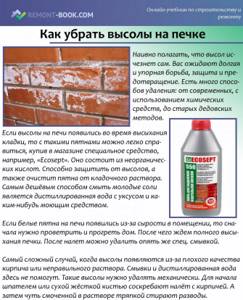
How to remove efflorescence from the stove
The work of a stove maker requires not only theoretical and practical knowledge, but also great responsibility. This is one of the few construction works where no assistants are involved; all operations are performed by the master personally and bears full responsibility for the results of his work. Even a slight deviation from the recommended technologies becomes the cause of defects; to eliminate them, you need to lose a lot of time and financial resources.
Preparing clay for mortar
To make a clay refractory mortar for laying stoves, you must first sift the clay through a sieve with 3 mm mesh. In addition, the material should be washed using a rather old, but still quite effective technique.
Flushing is carried out as follows:
- An oblong container is installed at an angle, and clay is poured into its upper part. The lower part of the container is filled with water so that it does not come into contact with the clay.
- Using a suitable tool, water is directed in waves towards the clay. The washed clay is slowly washed off into the water. A sieve is used to separate clean clay from water.
- The washed clay is laid in layers up to 20 cm thick, each of which is filled with clean water. After a day, this entire mass must be thoroughly mixed, clay added if necessary and left for another day.
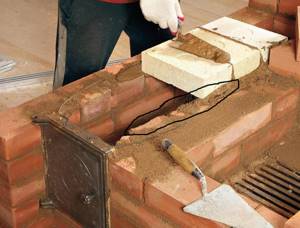
Clay purified using this technology is quite suitable for creating oven mortar.
How to build a fireplace with your own hands?
Having prepared the necessary materials, you need to solve the main question of how to build a fireplace.
To build a stove or fireplace (see Laying brick fireplaces), you will need to make a solid base and prepare masonry patterns, which are called ordering.
Preparing the base
If the floors in the house are made of reinforced concrete slabs, laying a fireplace with your own hands does not require the construction of a foundation. In all other cases, it is necessary to do this in order to ensure the stability of the fireplace and avoid its destruction.
- Dig a pit 50–70 cm 10–15 cm larger than the lower projection of the fireplace .
- Place a layer of crushed stone at the bottom of the pit and compact it.
- Install formwork in the pit, the height of which should be 5–6 cm below the level of the finished floor.
- Place rubble stone in layers in the formwork and fill it with a creamy cement-sand mortar prepared in the ratio 1:3.

Foundation structure - Level the top of the base, cover with film and leave to dry for 7–10 days.
Important! The base for a stove or fireplace should not be connected to the foundation of the house!
Orders
An order is a very detailed diagram that indicates the position of each brick. Please note that the ordering is done separately for each row of masonry.
Only an experienced craftsman can fold a fireplace without order, but a beginner will not be able to do the job correctly without it. Therefore, the order must be prepared independently, or even better, order a good stove maker to draw up a diagram for your fireplace.
Orders allow you to accurately calculate the required amount of material and not get confused during laying. Each row that has already been laid should be marked with the serial number of the corresponding order.
Work technology
It is necessary to lay two layers of waterproofing on the base of the fireplace under the first row of masonry. The basement row is usually laid “on edge” so that it is higher than the level of the finished floor. In all subsequent rows the brick is laid flat.
Before laying, the bricks are soaked in water for 2–3 minutes to ensure closer contact with the mortar.
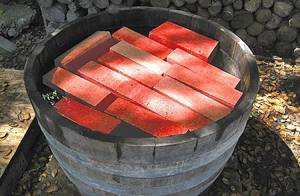
Soaking bricks before laying
The bottom of the fireplace insert should be located at a height of two or three rows of masonry from the floor level.
If you decide that you can do the laying of fireplace stoves with your own hands, you definitely need to consider the following: red and refractory bricks have different parameters of linear expansion when heated .
Therefore, there are some features of their simultaneous use in a single design. Since the fireplace insert is made of refractory brick, which gives greater linear growth, during operation it can cause destruction of the fireplace body, made of red brick.
To prevent this from happening, it is necessary to use “dry seams”, that is, lay out the fireproof insert of the fireplace without ligating it with the outer walls, stepping back from it by at least 2–3 mm.
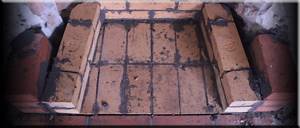
Furnace masonry
In this case, the firebox is provided with freedom to expand, and the space between the masonry creates thermal resistance, preventing the fireplace body from getting too hot.
The laying of the floor above the firebox opening requires special attention . Here it is undesirable to use metal or reinforced concrete lintels, which can be severely deformed when heated.
You can lay out the brick in the form of an arch or an even horizontal ceiling, with a certain protrusion, using special formwork.
There are several options for laying floors:
- wedge,
- arched,
- archery
In any case, before starting work on laying the floor, it is necessary to make formwork, which must exactly match the lower contour of the firebox arch. The formwork is designed in such a way that after the mortar has hardened, it can be lowered and removed without effort, without damaging the masonry. To do this, it is supported by bars in the upper part.
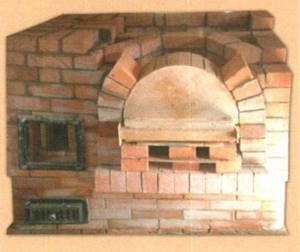
Furnace roof masonry
Arched and beam lintels are laid flat on the formwork, and to install wedge-shaped ceilings, the brick is turned on its edge. The thickness of the seams between the bricks in the lower part is about 3 mm , and in the upper part - 25 mm or more.
The lintel is laid on both sides and ends with the installation of a central brick, which is placed strictly in the middle of the arch vertically. Of course, the brick for laying this part of the structure must be selected especially carefully.
Popular baking mixtures
The recipe for preparing masonry mortar may vary depending on the specific requirements imposed by external conditions. The only constant component is clay - the remaining components are added to the mixture optionally. Most often, in addition to clay, the solution recipe includes sand - but you can also do without it if the fat content of the clay makes this possible.
There are other materials that are added to the fireplace mortar and give it certain properties. Regardless of the composition, mixing begins with dry ingredients, which are subsequently diluted with soaked clay.
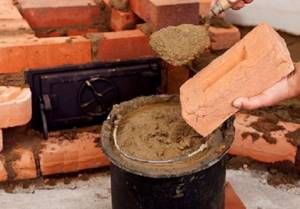
However, if you do not want to create a solution for laying stoves and fireplaces yourself, you can purchase a ready-made mixture for fireplaces and stoves. There is a fairly extensive range of such mixtures on the market, so there is always the opportunity to choose the best option that combines high quality and low price.
Ready-made heat-resistant mixtures for stoves, depending on their purpose, can be used for masonry, plastering, grouting, arrangement of the firebox and other work related to the installation of stove equipment. If necessary, you can even purchase a special solution for sauna stoves, which is highly resistant to moisture.
Brick
Types of bricks for laying fireplaces
Quartz refractory brick
Do-it-yourself fireplace masonry using solid red clay bricks. It is used to build the outer part of the fireplace, and for the facade you should choose smooth bricks of the correct shape without chips and cracks.
For that part of the stove or fireplace that is in direct contact with an open fire, a special fireproof fireclay or quartz brick is selected.
Hollow facing bricks can also be used, but only for laying the head of a pipe above the roof or for cladding a finished fireplace.
Brick quality requirements
Before you build the fireplace yourself, you should make sure that the material is chosen correctly.
When choosing a brick, the following requirements must be observed:
- Give preference to bricks of a grade not lower than M 200 . Products of this brand look better in appearance than bricks of lower brands, and, most importantly, they have high strength, withstanding a permissible load of 200 kg/cm² .
- Buy the required amount of bricks at once so that they all come from the same batch and have the same characteristics.
- Assess the external condition of the brick: absence of cracks, chips, presence of chips in the pallet.
Fireplace mortar
One of the most popular recipes for masonry mixtures for stoves is a mixture in which sand and clay are used in a one-to-one ratio. If the clay is too oily, then you need to take not one part of sand, but two. The finished mixture should have a fairly thick consistency like sour cream.
It is recommended to check the quality of the prepared mixture, for which you need to connect two bricks with it, let them stand for about 5 minutes and try to lift the structure by the brick located on top. If the composition is of sufficient quality, then two connected bricks can be lifted several times without them falling apart.
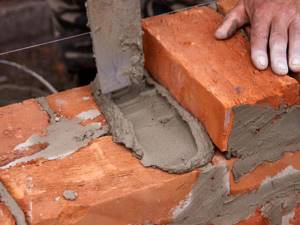
The only thing for which this composition is not suitable is laying the section of the chimney located above the roof, since it requires resistance to moisture. To arrange it, it is better to take a mixture of three parts sand and one part lime paste. You can also use a composition of one part quicklime and three parts plain water.
Plaster for stoves and fireplaces
There are several standard plaster compositions that are used to coat furnace equipment:
- Lime mixture . This composition is created from clay dough, lime and asbestos. The proportion is very simple - two parts sand, one part lime and a tenth part asbestos.
- Cement mixture . Clay and cement for a fireplace in this composition have the same volume. You need to take two parts of sand, and add a tithe of asbestos to all this.
- Fiberglass mixture . The composition of such a mixture is one part clay, two parts sand, one tenth fiberglass.
Facing mixtures
The composition for lining the furnace differs only in the presence of cement, the volume of which, when creating the mixture, coincides with the volume of clay. In addition, a double portion of sand is used for mixing. Experienced stove makers supplement this composition with a small amount of salt - it protects the structure from cracks.
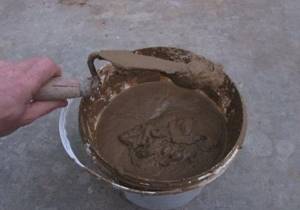
There are quite a lot of variations of facing compositions. For example, there is an option in which there is no clay at all. This fireproof mortar for stoves is well suited for laying tiles, but it must be left in water for at least two hours immediately before installation.
Stages of making your own solution
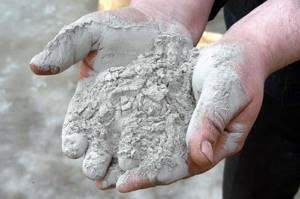
You can make a mortar for the fireplace masonry with your own hands after first selecting clay and sand. When performing work, the following technology is observed:
- Preparation of materials. The clay is soaked with water and sifted through a fine-mesh sieve. The sand is cleaned dry.
- The sand is mixed with clay and passed through a sieve again to obtain uniformity and crush possible clots.
- The mixture is checked for plasticity - it should slide smoothly from a trowel or shovel. Using this condition, a reference seam thickness of 3 to 5 mm is achieved.
- Increasing the strength of the solution. You will need to add ¾ liter of Portland cement per 1 bucket of the composition or table salt in an amount of 150-250 g. The cement is diluted with liquid to a creamy state, the salt is dissolved in water.
To lay 100 bricks flat for a fireplace with a seam of 5 mm, you will need 2 buckets of the mixture. When building a Russian stove, material consumption increases by 20%.
When laying a fireplace structure or stove yourself, it is necessary to check the quality of the mortar. The service life of the structure, protection from carbon monoxide and fire situations will depend on the ratio of the components.
